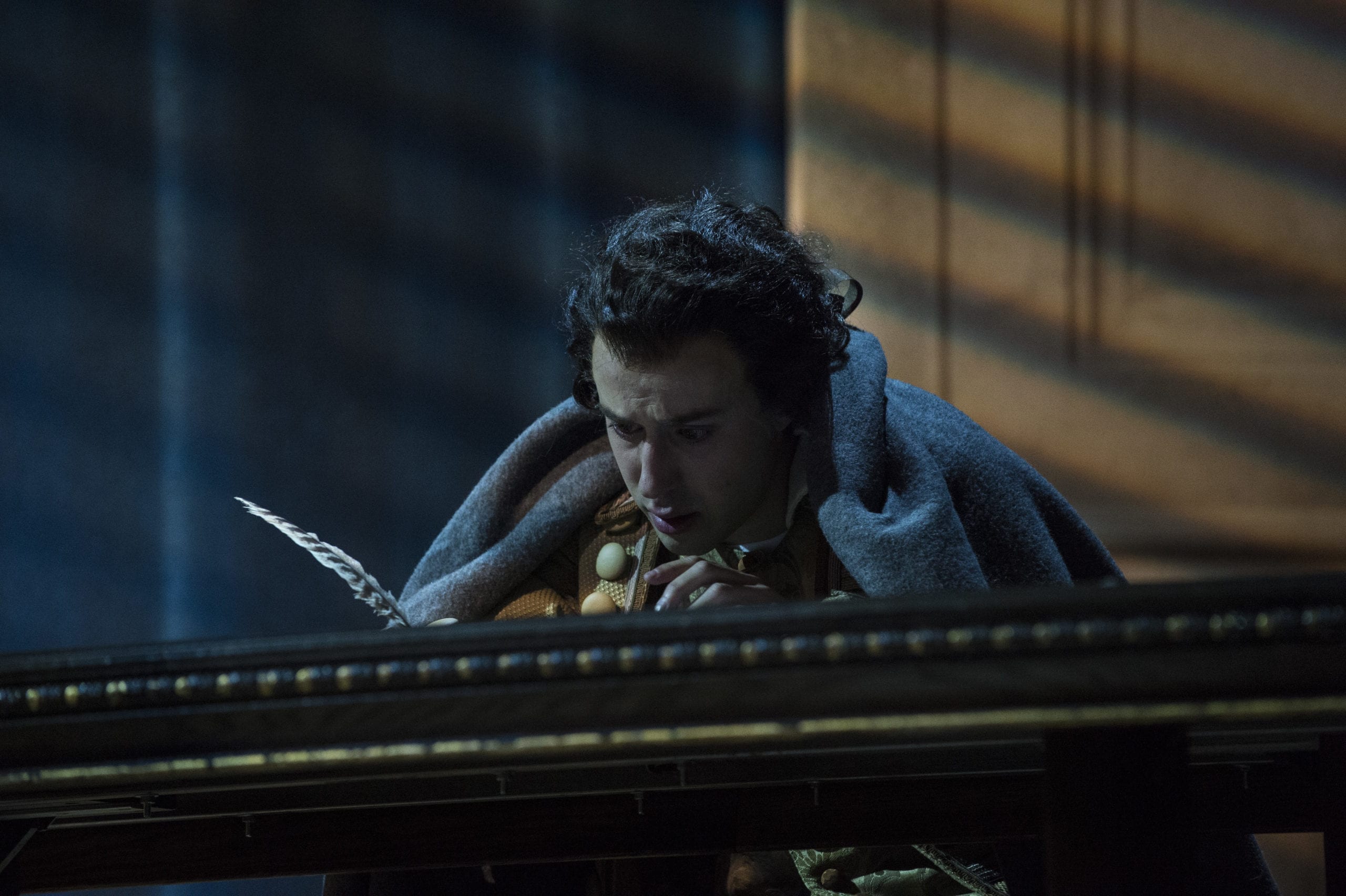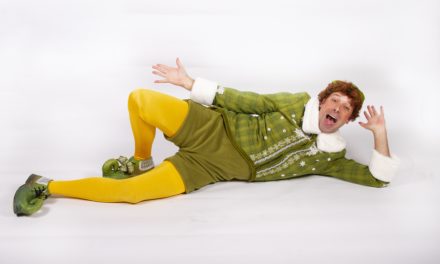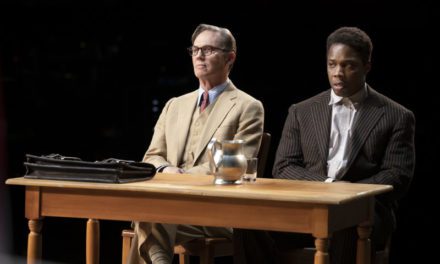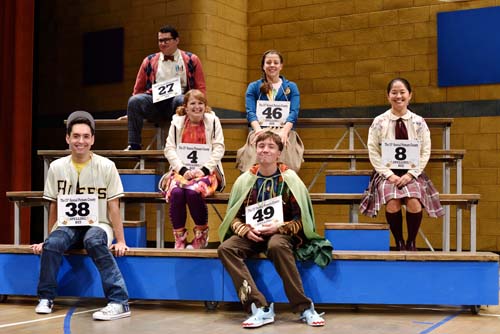CEDAR CITY — Rumors abound in 1823 Vienna that an elderly Antonio Salieri, former composer to the Emperor, says that he poisoned his fellow composer, Wolfgang Amadeus Mozart, 32 years before. Did he do it after all? Salieri himself summons the audience to hear his explanation of the events. And the result, at least in the Utah Shakespeare Festival’s adaptation of Amadeus, is enthralling.

Tasso Feldman as Wolfgang Amadeus Mozart in the Utah Shakespeare Festival’s 2015 production of Amadeus. (Photo by Karl Hugh. Copyright Utah Shakespeare Festival 2015.) Show closes September 5, 2015.
Peter Shaffer’s script is better known as his adapted screenplay of the same name, which won several Oscars in 1984, including one for Best Picture. Children of the 1980’s likely remember Tom Hulce’s Mozart, the genius child prodigy with terrible manners and that particular, maddening, and memorable laugh. The play has details that are very different than those in the movie, which is why I recommend that you do not watch the movie before coming to see the play. It will spoil your fun. The two versions of Shaffer’s work are different works of art, and viewers who expect a live-action version of the film will be disappointed.

David Ivers as Antonio Salieri in the Utah Shakespeare Festival’s 2015 production of Amadeus. (Photo by Karl Hugh. Copyright Utah Shakespeare Festival 2015.)
Under J. R. Sullivan’s direction, Salieri, aided by the action on the stage, transports the audience back in time. First, we arrive in Vienna in 1823 to see an aging Salieri, sitting in his wheelchair, looking like a mixture of Scrooge and the ghost Jacob Marley. As Salieri’s story begins, we are propelled back to the Viennese court in 1781, 32 years prior. The play itself is not as serious as it would seem; it has its moments of hilarity (the cast’s comedic timing is very good). But the cast also plays the serious parts really well; you can’t help but be roped in towards the actions on the stage.
David Ivers does a fantastic job in his portrayal of Salieri. He ages and becomes younger seamlessly throughout the story. When needed, he provides the weight of age and regret in his voice as an old man, and I could hear the strength and drive of his character when he begins his tale as a court composer. Having never seen Ivers in a production before, I actually thought he was an older man than he actually is when his character first appears.
Ivers’s height and booming voice help him dominate the stage as Salieri. His presence, aided by his wardrobe, commands the audience’s attention throughout most of the play. Indeed, Ivers almost never leaves the stage—it’s his character’s story, after all—and the only clues provided as to whether he was present during conversations throughout different scenes are changes in his demeanor or changes in lighting.

Betsy Mugavero (left) as Constanze Weber and David Ivers as Antonio Salieri in the Utah Shakespeare Festival’s 2015 production of Amadeus. (Photo by Karl Hugh. Copyright Utah Shakespeare Festival 2015.)
Salieri starts as the bad guy, yet I wanted to root for him, especially in the scene where he first meets Mozart (Tasso Feldman). Mozart and his fiancee Constanze (Betsy Mugavero), stumble into a room while they chase each other, flirting racily. Unbeknownst to them, Salieri is quietly eating crème de mascarpone in a concealing chair, awkwardly witnessing the scene. The question arises in Salieri’s mind: how on earth did this vulgar creature became a world-renowned composer? But when Salieri describes Mozart’s music later in the scene, it’s clear to Salieri that Mozart is, nevertheless, an instrument in God’s hands.
One memorable thing about Mozart’s portrayals in Amadeus is the laugh. That farcical, fantastical, buffoonish laugh that gives a terrible first impression of Mozart, and it makes people want to hate him and to understand why Salieri does. Feldman’s Mozart laugh (a mixture of Pee-Wee Herman’s laugh and Mark Hamill’s The Joker) helps carry on that tradition in this production. Feldman’s portrayal of Mozart’s buffoonery is over-the-top when it needs to be, and it’s impactful enough to make me wonder (much like Salieri) how in the world this man, who could not take life seriously, be such a good composer. Feldman transitions his character well from a wealthy, eccentric, ambitious prodigy to a humble, modest, yet still talented (albeit penniless) Mozart. He also maintains a sweet innocence throughout his portrayal, which is what gains the audience’s sympathy for his character’s situation. Feldman’s portrayal, however, always remains secondary to that of Ivers’s, and I’m not sure if it’s the script, the portrayal, or the direction. But when both are together on stage, Ivers dominates. I was expecting more scene stealing from Mozart’s character and didn’t get it.

David Ivers as Antonio Salieri in the Utah Shakespeare Festival’s 2015 production of Amadeus. (Photo by Karl Hugh. Copyright Utah Shakespeare Festival 2015.)
Feldman and Mugavero had great chemistry as a couple, and I really believed that Mozart and Constanze were in love. The script allows the characters to grow and evolve from a young couple that was materialistic and flippant to one that unites under hardship. Mugavero’s portrayal was particularly wrenching in her solo scene with Salieri, when you knew she did not want to be unfaithful to her husband, but later was willing to make that sacrifice in order to advance Mozart’s favor in the Austrian court.
The supporting cast held up the play well. My absolute favorites were Brandon Burk and Anthony Simone as the Venticelli, or “little winds,” the “purveyors of information, gossip, and rumor.” Their synchronized line delivery at the play’s opener and rapport throughout was mesmerizing and magical. It feels as though they have always been inseparable. John Pribyl’s Emperor Joseph II was both funny and inept. Saren Nofs-Snyder as Teresa Salieri and Kaitlin Margaret Mills as Katherina Cavalieri were impressive, even though their characters did not utter a word. Their physical demeanors spoke more about who their characters were than words could provide. Nofs-Snyder’s Teresa was exactly the dull and prop-like wife that Salieri describes. Mills’s Katherina was vivacious and precocious; Teresa’s exact opposite. As secondary characters that don’t speak, I wanted them to—I wanted to hear their stories and their side of the events that transpired. And while the script did not allow that, it did allow for the dichotomy of these characters to echo that of Salieri and Mozart.
My only disappointments with this play have nothing to do with the actors. The characters of the two Counts and the Baron are nearly interchangeable, for which I fault the script. And at some points, the blocking was maddening. As impressive as Mozart’s frocks are, there are several scenes were that’s all you see, as his back is to the audience. I don’t know if this was done on purpose due to the space, but good blocking is Theater 101, and I expect better from a play at the Utah Shakespeare Festival.
I have to give major kudos to the design team. David Kay Mickelsen’s costumes seem to come straight from the Emperor’s court tailor. Mozart’s costuming in particular chronicles well his devolution from stardom to pauper’s funeral. In the first act, his clothes reflect his extravagant, vulgar tastes. As the story continues in the second act, his clothes and even his wigs become more muted, until all the frills are gone, along with his money and his sanity. In contrast, Salieri’s clothes reflect the opposite path his life takes. Jack Magaw’s use of space in his set is quite interesting. The downstage and upstage areas are well delineated; a rear screen helps set the scenes as vignettes; and the tassles in the curtains are actually painted—a detail so well done I didn’t notice it until almost the end of the second act. The furniture reflects well late 18th century aristocratic taste, and the food props almost became their own character and help set up some important scenes.
The lighting (designed by Kirk Bookman) conveys well the mood and the focus of each scene. Sound designer Barry G. Funderburg had me fooled into thinking that Mozart and Salieri were actually playing the harpsichord. Funderburg also seamlessly inputs Mozart’s music into the play in subtle entrances, slowly crescendoing them to match Salieri’s descriptions.
Overall, due to the strong performances, psychologically charged script, and detailed design, this Amadeus rocked me, and it’s a rocking good start to the Utah Shakespeare Festival. Due to the nature of some scenes, this play is best for those family members over 13. Nevertheless, it is definitely worth the drive to Cedar City to watch.





